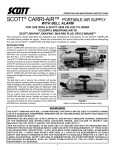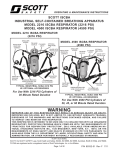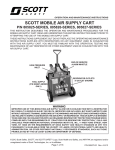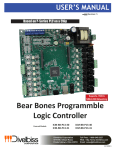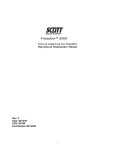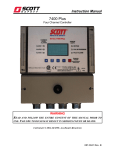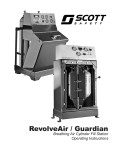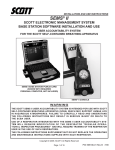Download ELSA EEBD - Scott Safety
Transcript
OPERATION AND MAINTENANCE INSTRUCTIONS SCOTT® ELSA® EMERGENCY LIFE SUPPORT APPARATUS ELSA 5 / ELSA 5HF / ELSA 10 / ELSA 15 WARNING IMPROPER USE OF THIS RESPIRATOR MAY RESULT IN SERIOUS INJURY OR DEATH. IMPROPER USE INCLUDES, BUT IS NOT LIMITED TO, USE WITHOUT ADEQUATE TRAINING, DISREGARD OF THE WARNINGS AND INSTRUCTIONS CONTAINED HEREIN, AND FAILURE TO INSPECT AND MAINTAIN THIS RESPIRATOR. THIS RESPIRATOR IS INTENDED TO BE USED ONLY IN CONJUNCTION WITH AN ORGANIZED RESPIRATORY PROTECTION PROGRAM WHICH COMPLIES WITH THE REQUIREMENTS OF “PRACTICES FOR RESPIRATORY PROTECTION,” Z88.2 AVAILABLE FROM AMERICAN NATIONAL STANDARDS INSTITUTE INC., 1430 BROADWAY, NEW YORK, N.Y., 10018, OR THE REQUIREMENTS OF OSHA SAFETY AND HEALTH STANDARD 29 CFR 1910 PARAGRAPH 134 AVAILABLE FROM THE U.S. DEPARTMENT OF LABOR, OCCUPATIONAL SAFETY AND HEALTH ADMINISTRATION, OR OTHER PERTINENT NATIONALLY RECOGNIZED STANDARDS. DESCRIPTION The SCOTT ELSA respirator is a lightweight, compact, self-contained breathing apparatus for emergency escape use only. When properly used, the SCOTT ELSA respirator provides emergency respiratory protection for escape from atmospheres which contain irritating or toxic contaminants, or are oxygen deficient. During use, it provides a constant flow of breathable air to the wearer for a limited time. The airflow is supplied to a loose fitting hood which can be donned quickly and encapsulates the entire head, sealing at the neck. The respirator may be worn in a ready position by the user or stored at the point of anticipated use. This respirator is for use at temperatures above 10° F/-12° C. The ELSA 5 and 5HF respirators have a rated duration of 5 minutes, the ELSA 10 respirator has a rated duration of 10 minutes, and the ELSA 15 respirator has a rated duration of 15 minutes. All four are intended for personal escape where the duration provided has been found to be sufficient to exit the area of hazardous atmosphere. The ELSA 5HF (Higher Flow) is intended for situations where the user may have to exert extra effort in the escape, such as in climbing ladders or stairs along the escape route. The ELSA respirator consists of three (3) major subassemblies: 1. The hood assembly with anti-fog wipe AFW 45 applied 2. The cylinder and valve/regulator/hose assembly 3. The pouch and harness assembly The ELSA respirator is approved by the National Institute of Occupational Safety and Health (NIOSH) for use during escape only. The ELSA respirator is intended for use only as described in these instructions and within the limitations of the label located on the cylinder and valve assembly and the NIOSH approval label located in the centerfold of this instruction. COPYRIGHT © 2004 SCOTT, ALL RIGHTS RESERVED 1 FIGURE 1 GENERAL LIMITATIONS ON USE The following general limitations are IN ADDITION TO AND DO NOT REPLACE THE SPECIFIC LIMITATIONS ON THE RESPIRATOR. 1. Personnel who intend to use this protective breathing equipment in a dangerous atmosphere MUST recognize its limitations and have the proper training in donning and operation of the equipment prior to use. 2. The protection offered by this respirator depends upon the training of the user, the suitability of the respirator to the application, and the condition of the respirator. 3. This respirator is intended for ESCAPE ONLY from atmospheres which become immediately dangerous to life and health. 4. This respirator only protects the user’s respiratory system, the head, and a portion of the neck from hazardous environments. If the environment contains substances which may irritate or poison through the skin, take the appropriate actions to protect the body such as the use of protective clothing, etc. 5. Do not use oxygen in this protective breathing equipment. Use only clean dry air in accordance with CGA Specification G-7.1 Type 1, Grade D or better with a dew point of -65° F/-54°C or lower. 6. This respirator MUST NOT be used for fire fighting. 7. This equipment must be properly maintained, inspected and tested by properly trained personnel in accordance with an organized respiratory protection program and these instructions. 8. This equipment must be protected from abuse or neglect which may cause malfunction. 9. Do not use this equipment for underwater use. 10. Use only in accordance with the NIOSH approval label located in the centerfold of this instruction and with the label located on the cylinder and valve assembly. WARNING DO NOT OPERATE THIS EQUIPMENT WHILE UNDER THE INFLUENCE OF DRUGS, ALCOHOL, OR ANY MEDICATIONS OR SUBSTANCES WHICH MAY AFFECT VISION, DEXTERITY, OR JUDGMENT. USERS OF THIS EQUIPMENT MUST BE IN GOOD PHYSICAL AND MENTAL HEALTH IN ORDER TO OPERATE SAFELY. DO NOT USE THIS EQUIPMENT WHEN FATIGUE PREVENTS SAFE OPERATION. STAY ALERT WHEN OPERATING THIS EQUIPMENT. INATTENTION OR CARELESSNESS WHILE OPERATING THIS EQUIPMENT MAY RESULT IN SERIOUS INJURY OR DEATH. WARNING THE IMPROPER USE OF A RESPIRATOR MAY RESULT IN SERIOUS INJURY OR DEATH. READ AND UNDERSTAND THESE INSTRUCTIONS AND ALL LABELS AND WARNINGS BEFORE ATTEMPTING TO USE THIS RESPIRATOR. RETAIN THESE INSTRUCTIONS FOR TRAINING AND FUTURE REFERENCE. WARNING ANY UNAUTHORIZED MODIFICATIONS TO THIS UNIT OR IN THE MAINTENANCE PROCEDURES, MATERIALS, OR PARTS USED MAY RESULT IN A MALFUNCTION OF THE RESPIRATOR WHICH COULD RESULT IN SERIOUS INJURY OR DEATH. WARNING THE SCOTT ELSA 5, ELSA 5HF, ELSA 10, AND ELSA 15 ARE EMERGENCY ESCAPE BREATHING APPARATUS INTENDED FOR USE BY PERSONNEL WHO HAVE COMPLETED A USER-TRAINING PROGRAM AS PART OF AN ORGANIZED RESPIRATORY PROTECTION PROGRAM. IMPROPER OR INCOMPLETE TRAINING IN THE USE OF THIS DEVICE OR FAILURE TO CAREFULLY FOLLOW THE INSTRUCTIONS IN THIS MANUAL MAY RESULT IN SERIOUS INJURY OR DEATH. 2 REGULAR OPERATIONAL INSPECTION NOTE THE FOLLOWING PROCEDURE MUST BE USED FOR NEWLY RECEIVED UNITS, AS WELL AS DURING ROUTINE INSPECTION OF UNITS IN ACCORDANCE WITH AN ORGANIZED RESPIRATORY PROTECTION PROGRAM. HEAVY USE AND EXTREME ENVIRONMENTAL CONDITIONS MAY WARRANT MORE FREQUENT ROUTINE INSPECTIONS. UNITS STORED FOR EMERGENCY USE MUST BE CHECKED AS DESCRIBED BELOW AT LEAST EVERY 30 DAYS. 1. 2. 3. 4. WARNING FOLLOW THE REGULAR OPERATIONAL INSPECTION PROCEDURE EXACTLY. IF ANY OPERATIONAL MALFUNCTION IS NOTED, DO NOT USE THE RESPIRATOR. REMOVE THE RESPIRATOR FROM SERVICE AND TAG IT FOR REPAIR BY AUTHORIZED PERSONNEL. FAILURE TO PROPERLY IDENTIFY MALFUNCTIONS MAY RESULT IN SERIOUS INJURY OR DEATH. Open flap of pouch and harness assembly and remove hood. Inspect the hood for discrepancies such as tears, cuts or abrasions, and for cracked or broken plastic parts. Inspect the neck opening to be sure that elastic band is not damaged or broken. The neck seal shall open and close easily and freely by hand. Inspect the diffuser and for the presence of the diffuser foam located inside the diffuser. See FIGURE 2. Remove the hose from the hood by unthreading the hose collar from the hood diffuser. DIFFUSER FIGURE 2 5. 6. Inspect the hose assembly for discrepancies such as tears, cuts or abrasions of the hose. Verify that the O-ring is present on the hose coupling. See FIGURE 3. The hose must be securely attached to the regulator but rotate freely at the regulator end. Inspect the regulator for exterior damage. O-RING FIGURE 3 3 7. 8. 9. Loosen the drawstring on the carrying bag and remove the cylinder. Check the latest cylinder hydrostatic test date to ensure it is current. All cylinders used with SCOTT self-contained breathing apparatus must be visually inspected regularly and hydrostatically tested by a licensed cylinder retester in accordance with the appropriate US Department of Transportation (DOT) specification or the applicable DOT exemption. For a complete listing of retest date requirements, refer to the current revision of Safety Precautions for Air-Pak Cylinders, Scott P/N 89080-01, available on request from Scott Health and Safety. The date of manufacture marked on the cylinder is also the date of the first hydrostatic test. It is the responsibility of your organized respiratory protection program to arrange for inspection and hydrostatic testing of cylinders by a licensed retester, in accordance with DOT standards. Visually inspect cylinder and valve assembly for physical damage such as dents or gouges in metal. Cylinders which show physical damage or exposure to high heat or flame, such as paint turned brown or black, decals charred or missing, pressure gauge lens melted or valve knob distorted, and cylinders which show evidence of exposure to chemicals such as discoloration, cracks in the cylinder and/or bulging of the cylinder wall, shall be removed from service and emptied of compressed air. Refer to current applicable publications on compressed gas cylinder inspection available from Compressed Gas Association Inc. (703-413-4341), 1725 Jefferson Davis Hwy., #1004, Arlington, VA 22202. Ensure cylinder is fully charged. At room temperature, the tip of the gauge pointer must be touching any part of the full band. See FIGURE 4. If the cylinder is not full, remove from service and tag for refilling by authorized personnel. See CYLINDER CHARGING PROCEDURE section of this instruction. WARNING DO NOT USE AN ELSA RESPIRATOR WITH A PARTIALLY DEPLETED CYLINDER. AN AIR SUPPLY CYLINDER THAT IS LESS THAN FULL WILL NOT PROVIDE THE FULL DURATION TO THE RESPIRATOR USER. SUDDEN AND UNEXPECTED TERMINATION OF AIR FLOW MAY RESULT IN SERIOUS INJURY OR DEATH. FIGURE 4 10. Inspect the carrying bag for cuts or tears and for damage to the strap, the strap hangers, and the strap clip. 11. If any discrepancies are noted, tag the unit for repair and remove from service. Discrepancies must be corrected by authorized personnel before returning unit to service. 4 After inspection, repack the ELSA respirator with a FULL air supply cylinder as follows: 1. On a smooth, flat surface, refold the hood as follows: a) Starting at the side opposite the diffuser, fold the longest dimension as shown in FIGURE 5A, making a rectangle, and gently flatten the hood. FIGURE 5A FIGURE 5B b) Fold the top part of the hood over the center, keeping the rest of the hood as flat as possible as shown in FIGURE 5B. c) Fold from top again overlapping the diffuser as shown in FIGURE 5C. FIGURE 5C d) Fold the neck opening to overlap the hood top. Flatted the hood toward the diffuser as shown in FIGURE 5D. e) Fold the neck opening over on itself as shown in FIGURE 5E. FIGURE 5E f) FIGURE 5D FIGURE 5F Position the diffuser on top of the folded hood as shown in FIGURE 5F. 5 2. 3. 4. Place the cylinder and valve assembly back in the carrying bag and secure the drawstring. Orient cylinder so the gauge will be visible through the transparent window. Attach the folded hood to the hose by threading the hose coupling collar onto the diffuser. Collar should be hand tight. Coil the hose into the hood pouch on the carrying bag followed by the folded hood. See FIGURE 6. TOOLS CAUTION SHALL NOT BE USED TO TIGHTEN THE HOSE COUPLING. USE OF TOOLS OR OVER TIGHTENING THE HOSE COUPLING MAY DAMAGE THE COUPLING, THE DIFFUSER, OR THE HOOD. WARNING HOSE COUPLING MUST BE PROPERLY THREADED ONTO THE DIFFUSER AND HAND TIGHTENED. A LOOSE OR CROSSTHREADED COUPLING MAY PERMIT LOSS OF BREATHING AIR WHICH COULD RESULT IN A FAILURE TO PROTECT THE USER FROM THE HAZARDOUS ATMOSPHERE CAUSING SERIOUS INJURY OR DEATH. FIGURE 6 5. 6. FIGURE 7 Close the cover of the carrying bag and secure with the hook and loop fastener. Verify that gauge is visible through transparent window. See FIGURE 7. Fully extend carrying bag strap and place unit back in service. FIGURE 8 6 DONNING AND USE OF THE ELSA RESPIRATOR DONNING FOR STANDBY The ELSA respirator may be worn in standby position either around the neck on the chest as shown in FIGURE 9A, or around the neck and under the left arm as shown in FIGURE 9B. The carrying bag must always be positioned with the gauge window facing out and with the pull tab on the hood pouch easily accessible. Move the harness strap to the appropriate “D” ring and adjust the strap length as desired for comfort. If the unit is stored at the point of intended use, the harness strap is to be stored in the fully extended position. FIGURE 9A FIGURE 9B USE OF THE ELSA RESPIRATOR Place the unit into operation as required with the following procedure: 1. 2. LIFT FLAP - to open carry pouch and expose hood. REMOVE HOOD – pull the hood fully out of the pouch. See FIGURE 10. FIGURE 10 3. WARNING FIGURE 11 OPEN VALVE - the valve must be completely opened by turning valve knob counterclockwise until it spins freely, approximately two full rotations. See FIGURE 11. The rated duration of the air supply begins when the valve is opened. T H E R AT E D D U R AT I O N O F T H E E L S A R E S P I R ATO R B E G I N S W H E N T H E A I R SUPPLY CYLINDER VALVE IS OPENED. DON THE HOOD IMMEDIATELY AFTER OPENING THE CYLINDER VALVE. FAILURE TO DON THE HOOD IMMEDIATELY MAY WASTE THE BREATHING AIR SUPPLY AND LEAVE INSUFFICIENT AIR FOR ESCAPE WHICH COULD RESULT IN SERIOUS INJURY OR DEATH. 7 4. VERIFY AIRFLOW – air must begin immediately to flow into hood as evidenced by sound of rushing air into the hood. 5. DON THE HOOD – remove any headgear and proceed as follows: a) Locate the elastic neck seal at the large diameter opening into which the head will be inserted and place hands into neck seal as shown in FIGURE 12. WARNING IF NO AIRFLOW IS DETECTED AS EVIDENCED BY SOUND OF RUSHING AIR, DO NOT USE THE RESPIRATOR. OBTAIN A N O T H E R U N I T. U N D E T E C T E D A I R FLOW MAY INDICATE INSUFFICIENT AIR FOR ESCAPE WHICH COULD RESULT IN SERIOUS INJURY OR DEATH. FIGURE 12 b) Spread hands to stretch open the neck seal and lower the hood over the head until the neck seal is around the neck. See FIGURE 13. FIGURE 13 FIGURE 14 c) Position the diffuser assembly in front of the face. d) Remove hands from the neck seal. There must be good contact between the neck seal and the neck. Be certain that clothing is not trapped in the seal and that long hair or beards do not protrude between the seal and the neck. See FIGURE 14. e) Verify that air is being delivered to the hood. The sound of air rushing into the hood and the inflation of the hood when holding your breath indicate that air is flowing into the hood. WARNING MAINTAIN GOOD CONTACT BETWEEN THE NECK SEAL AND THE NECK. POOR CONTACT BETWEEN NECK SEAL AND NECK MAY REDUCE THE PROTECTION OFFERED BY THE RESPIRATOR AND MAY RESULT IN EXPOSURE TO THE HAZARDOUS ATMOSPHERE WHICH COULD CAUSE SERIOUS INJURY OR DEATH. 8 6. 7. LEAVE HAZARDOUS AREA FOR SAFE AREA - While departing for safe area, hold the air supply to the body to keep the unit from moving excessively. FIGURE 15 REMOVE HOOD WHEN IN SAFE AREA - After use and when in a safe area: a) Remove the hood by reversing the donning procedure above. See FIGURE 16. FIGURE 16 FIGURE 17 b) Rotate the cylinder valve knob clockwise to close the valve. See FIGURE 17., c) Remove the carry pouch from the body d) Tag unit for inspection, cleaning, and recharging by authorized personnel. WARNING DO NOT WEAR HOOD AFTER AIR FLOW STOPS. WHEN THE SOUND OF RUSHING AIR STOPS, OR WHEN THE HOOD STOPS INFLATING WHEN THE USER MOMENTARILY HOLDS HIS/HER BREATH, THE BREATHING AIR SUPPLY IS EXPENDED. FAILURE TO REMOVE THE HOOD FROM THE HEAD AFTER THE AIRFLOW STOPS MAY RESULT IN SUFFOCATION WHICH MAY CAUSE SERIOUS INJURY OR DEATH. 9 CLEANING AND MAINTENANCE This procedure does not address any specific types of decontamination that may be necessary. Any required decontamination procedures must be established by the user’s respiratory protection program and performed before completion of routine cleaning and maintenance. The following procedures must be performed following each use. Separate the unit into its major subassemblies as follows: 1. Remove the hose from the hood by unthreading the hose collar from the hood diffuser as shown in FIGURE 18. 2. 3. 4. 5. 6. 7. 8. 9. FIGURE 18 Remove the cylinder and valve assembly from the carrying bag assembly by loosening the drawstring and lifting the cylinder and valve assembly out of the bag.. Clean the exterior surfaces of the cylinder and valve assembly, the hose, and the carrying bag with a damp sponge and allowed to completely air dry. If heavy soil must be removed, use a mild detergent solution, rinse thoroughly, and allow to completely air dry. Carefully wash the hood assembly, the diffuser cap and the diffuser foam insert with warm (110° F/ 44° C maximum) mild soap or detergent solution. Use care to avoid any scratching or abrasion of the hood. Rinse the hood assembly and associated parts by flushing with water, allowing water to flow through hood. Disinfect the hood and associated parts sponging the inside of hood with a 70% solution of Isopropyl Alcohol. Allow hood to completely air dry. Diffuser foam must be completely dry before reassembly. Turn hood inside out. Apply anti-fog wipe AFW 45 to each half of the hood and buff to a clear finish with a lint free cloth. The anti-fog wipe AFW 45 provides improved vision when the unit is used at temperatures below 32° F/0°C. Turn hood right side out. Recharge the air supply cylinder according to the CYLINDER CHARGING PROCEDURE section of this instruction. Perform the REGULAR OPERATIONAL INSPECTION as described in this instruction and repack the ELSA respirator for its next use. WARNING APPLY THE ANTI-FOG WIPE AFW 45 TO THE INSIDE OF THE HOOD AS INSTRUCTED. FAILURE TO APPLY ANTI-FOG WIPE AFW 45 TO THE INSIDE OF THE HOOD MAY RESULT IN FOGGING OF THE HOOD WHEN USED CAUSING OBSCURED VISION WHICH COULD LEAD TO SERIOUS INJURY OR DEATH. 10 CYLINDER CHARGING PROCEDURE Two different pressure cylinders are used with the SCOTT ELSA respirator: 1) 2216 psig for the 5 minute, and 2) 3000 psig for the 5 minute HF (high flow), for the 10 minute, and for the 15 minute. Verify that the charging equipment recharge pressure does not exceed the rated cylinder pressure. If cylinder pressure gauge does not read “FULL,” recharge is required. Proceed as follows: 1. Lift pouch flap and detach the supply hose assembly from the escape hood by unscrewing the knurled collar from the diffuser. 2. Turn cylinder valve clockwise to ensure cylinder valve is closed. 3. Loosen the drawstring and remove the cylinder and valve assembly from the carrying bag. 4. Inspect cylinder and valve assembly for hydrostatic test date, deep nicks, cuts, damage to the cylinder valve or evidence of high heat exposure. If discrepancies are noted, do not refill. Tag cylinder “Do not use - out of service.” Do not refill any cylinder which is not within the prescribed test date. 5. Place cylinder in a suitable “fragmentation” container. The container must be constructed to prevent personal injury in the event of component failure while recharging. SCOTT does not recommend the use of a water bath while charging cylinders. A water bath must not be used as a fragmentation container. 6. Remove the protective cap from the charging inlet port on the cylinder valve. 7. Connect Coupling Assembly, (.825 –14 NS-RH Thread) from air source to inlet port of cylinder valve. Be sure recharge pressure does not exceed rated pressure of cylinder: 1) 2216 psig for the 5 minute, and 2) 3000 psig for the 5 minute HF (high flow), for the 10 minute, and for the 15 minute. Use clean dry air in accordance with CGA Specification G-7.1 Type 1, Grade D or better with a dew point of -65° F/-54° C or lower. 8. With cylinder valve fully closed, slowly open charging valve and fill cylinder to “FULL” at a rate not exceeding 1500 psig per minute. Cylinder charging causes a rise in temperature. Allow cylinder to cool to room temperature. After cooling, cylinder must be topped to service pressure. 9. Close charging valve. Bleed residual pressure from charging line before disconnecting charging fitting. 10. Disconnect charging fitting. Replace the protective cap on the charging inlet. 11. Check for leaks from the end of the supply hose by immersing the open end of the hose in clean water. If bubbles are detected leaking from the open end of the supply hose, tighten the cylinder valve knob until the leak disappears. Do not use excessive force on the cylinder valve knob. If the leak does not disappear, remove the unit from service and tag for repair by authorized personnel. 12. Check for leaks in the cylinder valve area by applying leak detector fluid around the cylinder gauge connector. Soapy water may also be used to detect leaks. Wipe clean afterwards. 13. Place the cylinder back into the carrying bag. Reconnect the supply hose assembly to the escape hood by screwing the knurled collar onto the diffuser hand tight. Repack the escape hood as detailed in REGULAR OPERATIONAL INSPECTION section of this instruction. WARNING HIGH PRESSURE AIR IS INHERENTLY DANGEROUS. FAILURE TO FOLLOW THE CHARGING PROCEDURE AND FAILURE TO EXERCISE CAUTION WHILE WORKING WITH HIGH PRESSURE AIR MAY RESULT IN A SITUATION WHICH COULD CAUSE SERIOUS INJURY OR DEATH. WARNING IF ANY LEAKS ARE DETECTED, REMOVE THE UNIT FROM SERVICE AND TAG FOR REPAIR BY AUTHORIZED PERSONNEL. FAILURE TO REMOVE LEAKING APPARATUS FROM SERVICE MAY RESULT IN INSUFFICIENT BREATHING AIR IN THE SUPPLY CYLINDER WHEN NEEDED IN TIME OF EMERGENCY WHICH COULD LEAD TO SERIOUS INJURY OR DEATH. 11 CAUTIONS AND LIMITATIONS JMNOS- Failure to properly use and maintain this product could result in injury or death All approved respirators shall be selected, fitted, used & maintained in accordance with MSHA, OSHA, & other applicable regulations. Never substitute, modify, add or omit parts. Use only exact replacement parts in the configuration as specified by the manufacturer. Refer to User’s Instructions, and/or maintenance manuals for information on use and maintenance of these respirators. Special or critical User’s Instructions and/or specific use limitations apply. Refer to User’s Instructions before donning. S-SPECIAL OR CRITICAL USER’S INSTRUCTIONS The ELSA 5, ELSA 5HF, ELSA 10, and ELSA 15 respirators are NIOSH approved to supply breathable air for a limited period of time to permit emergency escape only from oxygen deficient or other life-threatening gas or vapor atmospheres. Ensure that the anti-fog wipe AFW 45 has been applied to the inside of the escape hood when the unit must be used at temperatures below 32° F / 0°C. Do not use this apparatus in temperatures below 10° F / -12° C. Health & Safety Products Monroe Corporate Center PO Box 569 Monroe, NC 28111 Telephone 1-800-247-7257 FAX (704) 291-8330 www.scotthealthsafety.com Printed in USA P/N 89504-01 Rev. B 11/04 12












